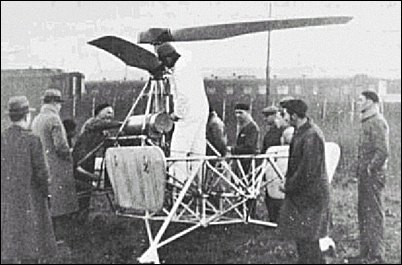As early as 1908 von Asboth had set about building a biplane, and during World War I he was Director of the Austro-Hungarian State Propeller Factory. He worked alongside von Karman, and in particular was responsible for the development work on the rotors for the Petroczy-von Karman helicopter.
Between 1928 and 1931, now working in Budapest, von Asboth tested various contra-rotating co-axial two-bladed rotors only 4.35m in diameter.
Stability was achieved in the helicopters on which they were used by the action of the air, which the rotors directed on to six mobile surfaces round the horizontal hinges. These six 'deflectors' were operated by the pilot, using traditional aircraft controls.
The fourth model, known as AH 4, had, instead of a Le Rhone 110hp rotary, a Clerget 130hp engine, which drove not only the rotors but also a tractor propeller. This rotorcraft in flying condition weighed 410kg, and could climb at a rate of 2m/s. During its tests, it proved stable but hard to handle. It reached a height of over 30m.
About 1930 two missions, one British, the other French, went to Budapest to check up at first hand on the results claimed by von Asboth. An expert in the British mission named Liptrot climbed to a height of 31m, and flew for a distance of 2800m. Von Asboth then completed his research particularly into his rotor system, the blades of which contained a movable part extending from the hub to the middle, and a fixed part from the middle to the tip of the blade. He then went to England, where the Blackburn Company became his licensee.
P.Lambermont "Helicopters and Autogyros of the World", 1958
Hungarian engineer Oscar von Asboth, who had worked on the two PKZ machines, designed and tested four different helicopters between 1928 and 1931.





